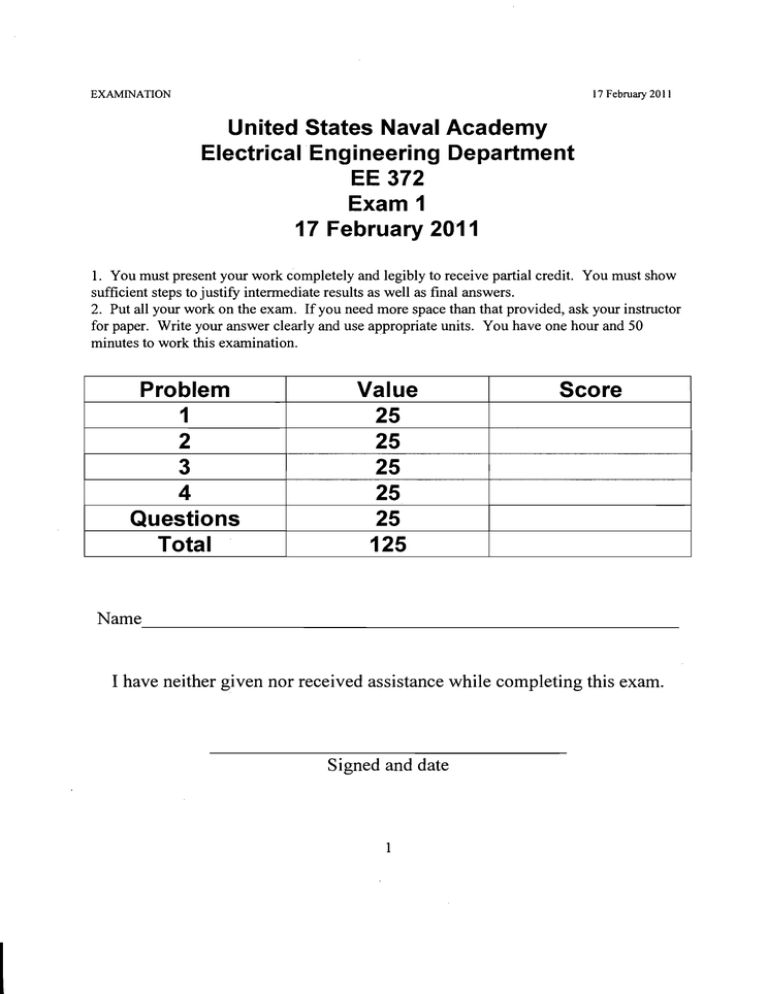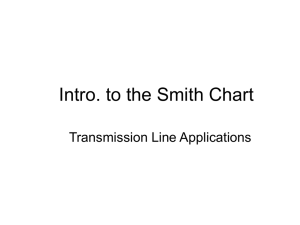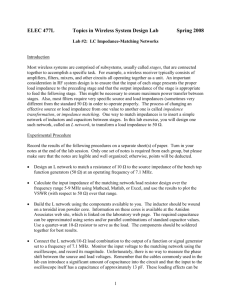Document 11090370
advertisement

17 February 20 II
EXAMINATION
United States Naval Academy Electrical Engineering Department EE 372 Exam 1 17 February 2011 1. You must present your work completely and legibly to receive partial credit. You must show
sufficient steps to justify intermediate results as well as final answers.
2. Put all your work on the exam. If you need more space than that provided, ask your instructor
for paper. Write your answer clearly and use appropriate units. You have one hour and 50
minutes to work this examination.
Problem
1
2
3
4
Questions
Total
Value
25
25
25
25
25
125
Score
Name-----------------------------------------------------
I have neither given nor received assistance while completing this exam. Signed and date 1
17 February 2011
EXAMINATION
(1)
(25 points) An air-spaced transmission line (sr
impedance Zo
=
=I ) oflength 0.4)" with characteristic
50 n is terminated with load impedance ZL. The voltage across the
load is VL= 1.5e - j50· V and the current through the load is IL = I 0.6e - j95· rnA. Find
the following: (You must use equations, not the Smith Chart).
(a)
The load impedance, ZL.
(b)
The reflection coefficient at the load, r.
(c)
The voltage 0.2)" away from the load.
(d)
The input impedance, Zin, 0.2)" away from the load.
(e)
Find the power delivered to (absorbed by) the load.
~o,i;l
:;>
a
20 ~ soru___
:
......-'
-2 -= ~ z..
v~
/t s-
(ef)
:; Va
e>
T
$7;>":::
fl-
(/
~
r
-j~~
/."'$;""e;.
//().
=/,
.
t-)t/;3) e.<rf ~o '/ 0/"01/ .f7.-. (l')
r (/-1­
d.'/J). .: :
=-].'J/ .... V
f:...
2
-=.
;> L rf
r =
~ 63 "'>\ V
EXAMINAnON
17 February2011
(2) (25 points) A radio is connected to an antenna in the configuration shown below. You plan to
make the input impedance at BB' equal to son. To do this, you will first make the impedance at
AA' purely real and then transform the real impedance so that Zin = son at BB' by specifying
the characteristic impedance of the transmission line between BB' and AA'. (You must use
equations, not the Smith Chart.)
~=~~~_f~B====_Z_:_4=====::===~~~---~-:1-=-5-0-Q-----Z-'1~~~~j~~OQ A.­
Zl
I':r=4 Radio
Vg=1 Ocos(60x1 061tt)V B'
A
~
Z01=50Q
~ I':r=4
I,~
(a) Determine the shortest length of h that when attached as shown would cause a purely real
impedance at AA'.
(b) What characteristic impedance transmission line should be used between AA' and BB'?
(c) Find the power delivered to (absorbed by) the antenna.
(c.v) 2;;,
(2}) ='"
'I,' (z- -;) =/lee
/0'0
0-
-I j/()o/U
c>oS-
-j
2;;. (yc.) :,
-j ZOD = J
=-
q'::'
~.:::
"0 ~ V
J ,(,; (ftt: ') = J o. oo.:s­
2J'A 0-G) =- - j
t{
o.
j
-60
(-:>-0)
200rU
~
~~(Ll..f)
-Iun O~'1 (C<.A))
6:0
_
.6,
L _
= /ov~
_8J~~~~~D.IPO
=lob', ~
1..4fl {".j >t' "-' ,
(c)
- O. 2//
,11-0-S'-)
=:
200
-/~'V 0.71' ~ )
-0, Z//
= 2,~· '0tl,l)
v:
d
0(270)
YYOJ
=
~
3
1
\14<1 = ~ LQ 12- I&- [v~ . J:j 'IL .a~L>- . o.!J EXAMINATION
17 February 2011
(3) (25 points) The input impedance 0.35A. away from a load is Zin= (0.4 -0.8j)Zo. Using the
attached Smith Chart, find: (Please annotate the Smith Chart for full credit) (You must use
the Smith Chart for this problem).
(a) The voltage standing wave ratio.
(b) The load impedance
(c) The load admittance
(d) The input impedance 0.85A. away from the load.
(e) The distance from the load to the nearest voltage maximum.
(~)
~,?-/
(6)
(01:2 r -t"j'
(C)
r;,;? (,
fcP )
0.
-j
22.\
2, / )
os)- o.s).:
/0, 7' ­
(e)
C;;.
0,
2-0 J1.­
Yo
-U­
0-5'S-)
?J ) Z:o
O~~/3')
4
The Complete Smith Chart
Black Magic Design
(~)
-10040 20
10
-40
20
]I)
10
15
7
1
I
-
0.9
OJI
0.9
0.7
2
2.5
0..
OJI
0.5
0.7
0.3
0.4
G..
•
0.2
0.5
9
i,n
RADIALLY SCALED PARAMeTI!RS
U
1.4
•
1.2 1.1 I
TOWARD LOAD-.
15
10
0.3
14
20
30-0
O.OS
0.2
0.01
00
12
0.1
0\
1.1
0.99
1.2
1.1
0.2
0.\
<- TOWARDCI!NI!RATOI. 2
I
S
7
II
10
0.1
0.4
1.6
0.4
1.3
1.2
US
1.4
1.3 1.4
0.. OJ!
J.5
0.9
1.6
1
J.I 2
\.5
4
I.' 1.7 IJ! 1.9 2
0..
OJ!
0.7
5
5
2.5
0.5
0.4
0.3
•
10
10_ 4 5
0.2 0.\ 0
CI!N'reI.
0.0
ORIGIN
0.1
G.2
O.J
0.4
0.5
0.'
0.1
OJ!
0.9
\.1
1.2
1.3
J.4
J.5
1.6
1.7
1JI
­
20 10 15­
\.9
EXAMINATION
17 February 2011
(4) (25 points) Design a 0.04 pF capacitor that operates at 10 MHz using an open terminated
coaxial cable of characteristic impedance lOon and dielectric constant of 9.5.
=
-
.I==
'].773h)
<'.-/l,J. ~ ~ N~..
-=
4'.
5
8'{'
.j.
7
hJ
(F72 '")
17 February 2011
EXAMINATION Questions:
(1) (5 points) In your introductory circuits class, why were you able to ignore the length of
the wires connecting circuit elements?
7"'.1 /'lCl,jen.- /'",.,
tv
~"''' J~/JJ,'<",
Ie"
c~" iL :/~~~J
~C!/.(
I.{«/> :r,)",/ ,,<.~.e ~(j Jl
Ine
F.l.r !-<r Ii.:: ~'.I))
/J
;.,"" ( '
(2) (5 points) Assuming a frequency of 5GHz, write the time domain representation of the
phasor V(z) = 6e j30' e- j5z + 2e- J50' e j5z V
(3) (5 points)When is it appropriate to use the lumped element circuit model?
(4) (5 points) Explain the utility ofa matched line.
#/1 /c~~e,5flJ
r:e
yt'/e.
~e. :Ire", -'
/.J ()
<-.>-€-
is
/e
c/e. ~'v-errc/ ~ :#'e /c 4~
~c~.//
Ai ) / , r
c~-4r
/-r
/,0 /.~i./
/___
tJ.,
/J/fO
:£. ~ a /I~ t./
r­
(5) (5 points) Why do you use an effective dielectric constant to analyze microstrip
transmission line designs?
H-~~J,l.i'
?"A~"- 76/-/ ... 1 c~ h5r/
/rCuJf.;"..-:.;r/c'"Yj
/rl}'e... 7:1< e .,c,/;~~--e. c1ele ck;c.
C'C)/)sJC-I\ -t
~cc-o c-'!J!5 ~ #e ~/J~&,Ic:.J ~n/
/ I e.. c<- I-
h
Cc
',,:-v c:.,
/6e
6
/1)
'--e; •







